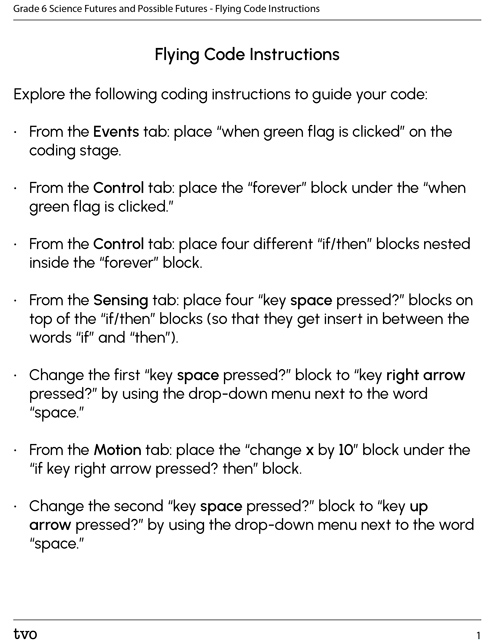Minds On
Thinking about flight
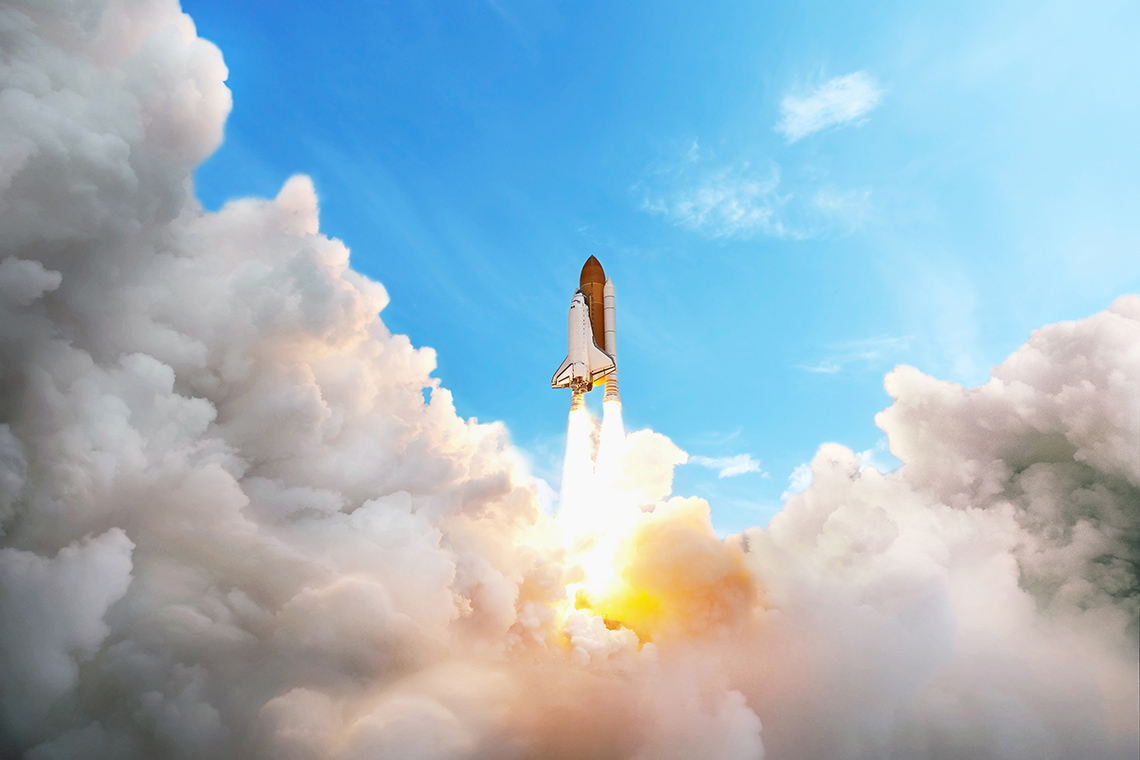
Inspired by animals and supported by technology, humankind has developed the ability to fly. From flying kites, lanterns, hot air balloons, gliders, to airplanes and spacecrafts, innovations in technology have allowed humankind to defy gravity, and reach not only new heights, but also new worlds!
In this learning activity, we will be investigating some of the innovative technologies that have contributed to our ability to fly to and explore space.
Brainstorm
Brainstorm
Let’s brainstorm any technologies or individuals who have contributed to the development of space exploration.
Record your ideas in a notebook or another method of your choice.
Action
Innovations in space exploration

Mission control at NASA
Space exploration has long been supported by emerging technologies, including those which are written in code by programmers.
Coding is a programming language that uses step-by-step instructions to communicate with computers tasks that we want it to perform.
Space exploration involves a lot of math and many, many complicated calculations and tasks. Before the advancement of computer technology, these essential calculations were done manually by the brightest mathematicians space agencies could hire.
In the United States in the 1950s, the soon-to-be-named National Aeronautics and Space Administration (NASA), hired a group of Black female mathematicians to be their human version of computers and they called them just that, the “computers,” because they did these calculations by hand. Among this group, was a woman named Katherine Johnson.
Spotlight on Katherine Johnson
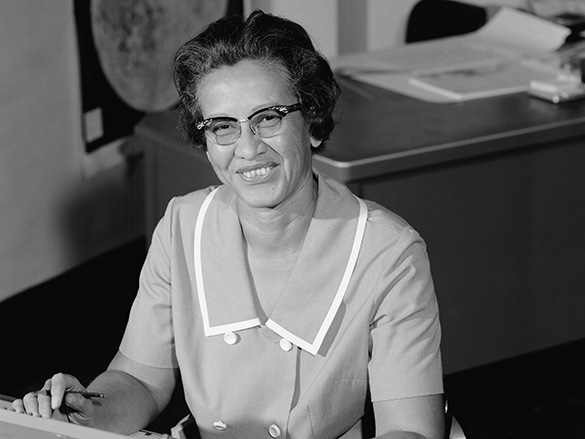
Katherine Johnson
Katherine Johnson was a teacher and mathematician, who began working at soon-to-be named NASA in 1953, as one of the human “computers.” She was brilliant at calculating numbers! She used her exceptional mathematics and problem-solving skills to advance space exploration, and to send astronauts to the moon.
When Katherine joined the soon-to-be named NASA, most of the staff were white men. During this time, across much of the United States, segregation laws were in effect. These laws meant that people were separated and discriminated against based on race. As a result, separate schools, housing, institutions, and facilities were created to maintain this separation and racial discrimination. Katherine overcame both racial and gender inequalities to contribute significant advancements in space exploration, and she is recognized as a trailblazer for equality.
Some of Katherine’s many contributions to space exploration include:
- Calculating the path for the Freedom 7 Spacecraft that sent Alan B. Sheppard Jr., the first U.S. astronaut, into space in 1961.
- Manually double-checking the orbital calculations produced by NASA’s physical computers after personally being requested to do so by astronaut John Glenn, the first U.S. astronaut to orbit Earth.
- She also contributed to several Apollo missions and the Space Shuttle program, just to name a few!
“I felt most proud of the success of the Apollo mission. They were going to the moon, and
I computed the path to get there.”
- Katherine Johnson
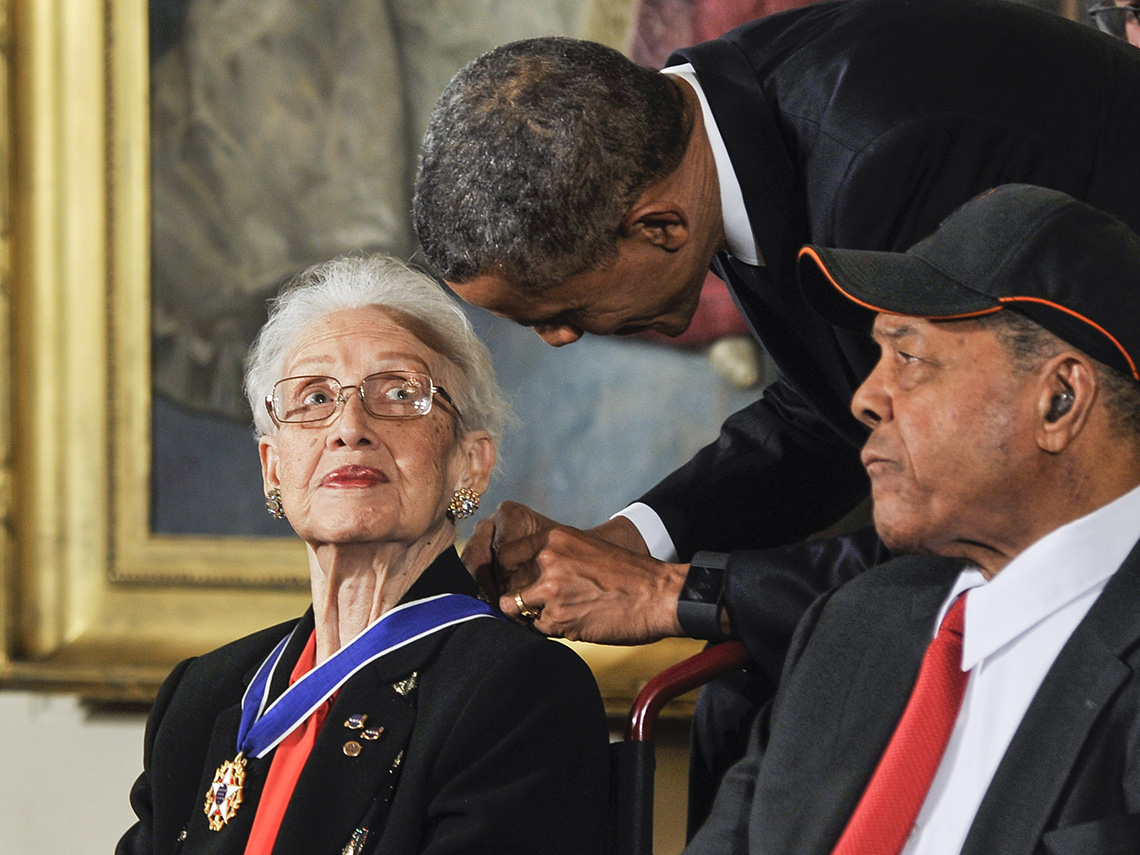
Katherine Johnson receives the Presidential Medal of Freedom from President Barack Obama (2015).
Katherine retired from NASA in 1986 after 36 years at Langley. During her career, she wrote and co-wrote 26 scientific research reports. Her invaluable achievements to STEM and space exploration were honoured in 2015, when she received the Presidential Medal of Freedom from President Barack Obama.
Katherine Johnson continues to inspire young people to explore mathematics and science, and to fight against racial inequity. In 2016, NASA dedicated the Katherine G. Johnson Computational Research Facility at the Langley Research Center which commemorated all the hard work and efforts made by Katherine over her many years working at NASA (Katherine G. Johnson, 2017).
The emergence of innovative technologies
In the early 1960s, as NASA was planning and preparing for the very complex mission that would send the first US astronaut, John Glenn, to orbit the Earth, the first physical computer machines were brought in to do the many and extremely complicated calculations and replace the human “computers” with its speed and efficiency.
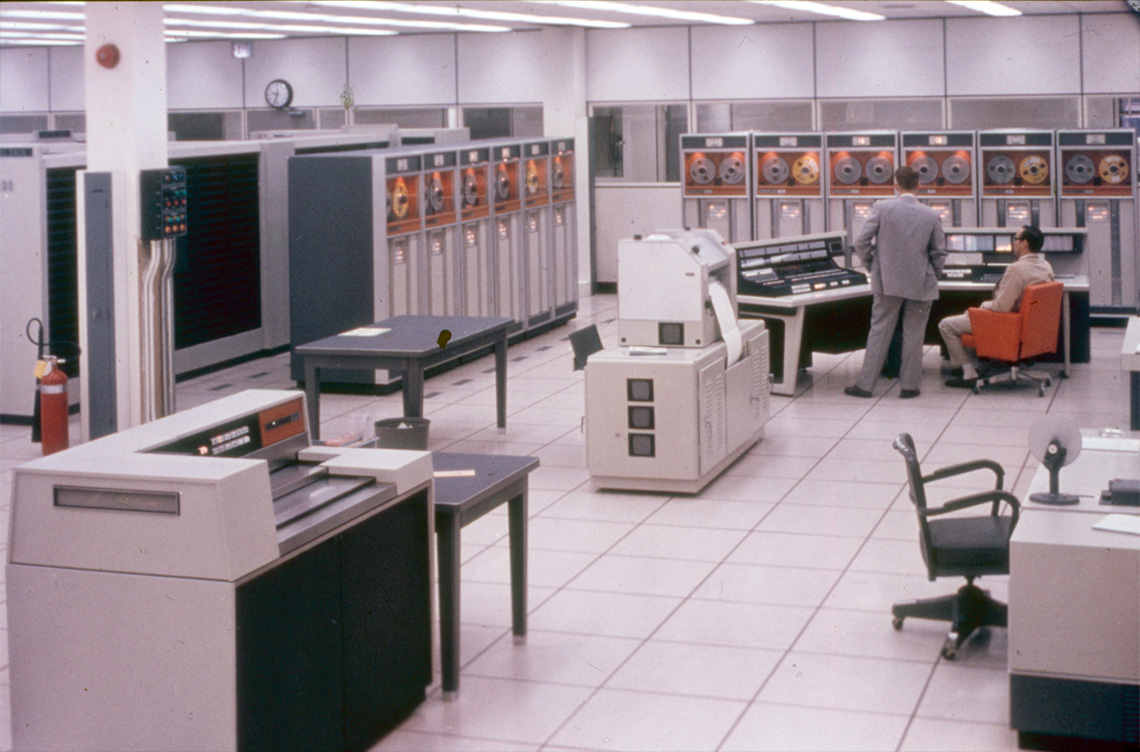
Computer room at NASA’s Manned Space Centre, 1960s
The IBM Card-Programmed Calculator (CPC) was an example of early innovative technologies that would greatly contribute to space exploration and our understanding of the world beyond our atmosphere (The Apollo Missions: Transforming the World, n.d.).
Innovations for exploring Mars
Aside from Earth, Mars is the most explored planet in our solar system.
Check out this video entitled “Mars” to learn a bit more about “the Red Planet”.
Pause and Reflect
Characteristics of Mars
Consider the following questions:
- Why is Mars called the Red Planet?
- What are some of the characteristics of Mars that are different from planet Earth?
Record your thinking in your notebook or using another method of your choice.
How do we know so much about the properties and characteristics of the Red Planet?
We owe a lot of this knowledge to a set of amazing technological innovations called the Mars rovers. Since 1997, five different rovers, or robot vehicles, have been sent to Mars to explore the planet and gather information on it.
The most recent rover, called the Perseverance, landed on Mars in February 2021 to investigate the planet for any past or present signs of life. This rover will hopefully allow scientists to determine if someday humans might be able to explore the planet themselves or maybe even try to live there!
Compared to previous versions of Mars rovers, the Perseverance is especially innovative because it included a special companion technology to help with its mission.
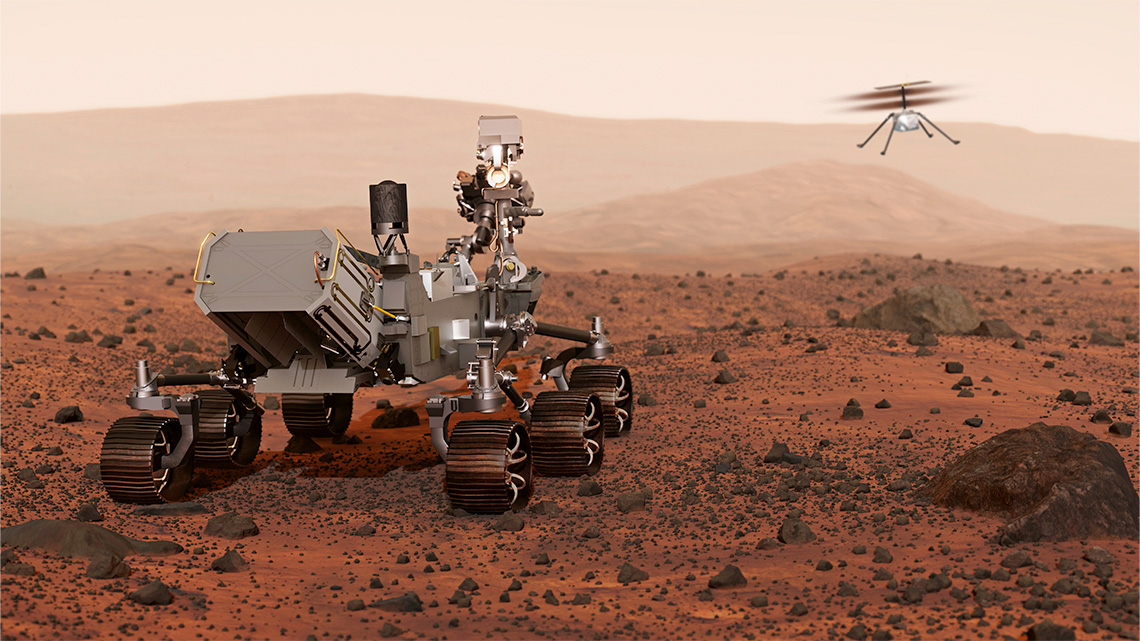
NASA’s Mars Perseverance rover and Ingenuity helicopter landed on Mars in February of 2021.
The Ingenuity, a small drone-like helicopter, travelled to Mars with the Perseverance and is the first attempt at using powered flying technology on another planet!
Mars’ atmosphere and climate are very different from Earth’s, so scientists needed to carefully consider the forces of flight, and how to manipulate them, to successfully fly the helicopter. The Ingenuity is a technology that proves that powered flight by a small, lightweight flying device is possible in the thin atmosphere of Mars.
The Ingenuity is programmed to fly on its own, without a human controlling it, but scientists are preparing for possible future versions that astronauts could use with remote controls to fly as scouts before they venture out to explore parts of the planet themselves.
Code your own Mars helicopter
Now it’s your turn to land a Mars helicopter!
NASA has created an activity using a coding app called Scratch.
Scratch coding works by selecting and placing different coding blocks from the menu tabs on the left of the screen onto the coding stage area, in the centre of the screen. The blocks will fit together like puzzle pieces.
Explore the following video instructions adapted from NASA’s Jet Propulsion Laboratory’s website on how to begin coding a Mars Helicopter Video Game.
Alternately, you may access the Flying Code Instructions document to examine each step to guide your code to make your helicopter fly.
Time to fly!
If possible, access Scratch and follow the step-by-step instructions to code the helicopter to fly up, down and side to side when the arrow keys on your keyboard are pressed.
Press Scratch to access the template and begin coding. The Mars backdrop and the helicopter sprite have already been uploaded for you, along with some of the basic blocks outlined in the video.
Access the following Scratch link to explore the code: Scratch(Opens in a new window)
Test it out

You are now ready to test your code!
- Make sure your helicopter is in the starting position on the ground to the left of the screen. Then, press the green start flag.
- Use your arrow keys to fly your helicopter up, over, and down into its landing position in the purple circle.
Were you able to land your Mars helicopter on the landing pad? If not, review your code sequence and make any necessary adjustments.
Press ‘Let’s Check!’ to access a breakdown of the completed code.
Check out the following image for a breakdown of the completed code sequence:
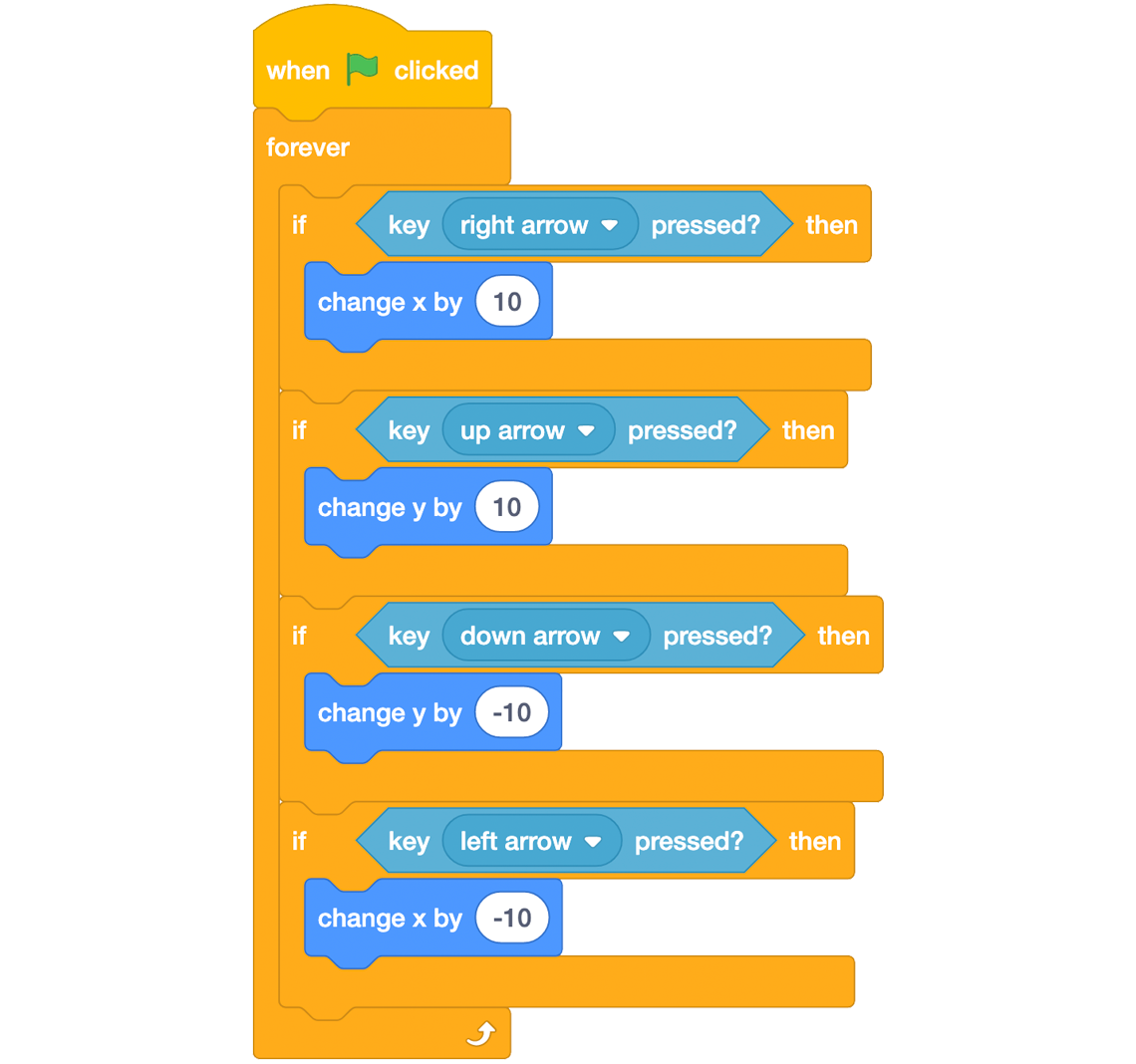
Complete code sequence
A scratch code block sequence that reads as follows: when green flag is clicked, forever repeat the following sequence: if key right arrow pressed? then change x by 10, if key up arrow pressed? then change y by 10, if key down arrow pressed? then change y by -10, if key left arrow pressed? then change x by -10.
You may use the following checklist to reflect on your project and your code:
When creating code, did you…?
Student Success
Let’s think!
How could you add or change the code to add more functions or components to your game?
Record your ideas in a notebook or another method of your choice.
If possible, share your ideas with a partner.
Coding alternatives
No access to Scratch? No problem!
Press the following tabs to access two alternative tasks.
Let’s reflect and respond to the following question:
What kinds of commands would a programmer need to consider in order to code a helicopter to fly on its own, without a human controlling it, on a planet such as Mars?
When answering the question, consider:
- What would the helicopter need to be able to do? (i.e. take off)
- What signals might the helicopter need to flag? (i.e. a collision)
- What does the helicopter do when it lands? (i.e. takes pictures, collects samples, etc.)
Record your ideas in a notebook or another method of your choice.
Explore the following image of a block code sequence that would code a helicopter sprite to move up, down, and side-to-side.

Complete Code Sequence
A scratch code block sequence that reads as follows: when green flag is clicked, forever repeat the following sequence: if key right arrow pressed? then change x by 10, if key up arrow pressed? then change y by 10, if key down arrow pressed? then change y by -10, if key left arrow pressed? then change x by -10.
After exploring the image, respond to the following questions:
- Explain what part of the code you think lifts the helicopter into the air.
- What portion of the code do you think changes the direction of the helicopter? Why?
Record your ideas in a notebook or another method of your choice.
Consolidation
Making connections

In this learning activity, we learned about different things that have contributed to space exploration, like Katherine Johnson, the emergence of computers and coding, and the Mars rovers!
These are just a tiny sample of contributions made and advancements in exploring the world beyond our atmosphere!
Do you know of any other technologies or individuals that have contributed to the exploration and understanding of space? Consider conducting research to continue your learning.
Press ‘Let’s Check!’ to access ideas of technologies and people that you might research.
- Dorothy Vaughn
- Chris Hadfield
- Mae Jemison
- arious Canadarm technologies
- Hubble Telescope
- International Space Station
Student Tips
Student tips
When researching it is important that you begin your search using websites, videos, audio recordings, or print resources from sources that would have reliable first-hand knowledge of the topic you’re researching.
Websites ending with .com, .org, and .net can be created and used by any person. Be careful when using these websites and ask yourself if these websites are credible or have bias. Those ending in .org are usually used by non-profit organizations, which may have an agenda of persuasion rather than education.
Websites ending in .edu are reserved for colleges and universities. Canadian websites have a .ca ending. It is important to consider using credible Canadian websites for research when possible!
What format will you choose to share your learning to educate others on the contributions and impacts of technology and individuals on space exploration?
Before sharing your work, you may review the following checklist to assess your work:
Did I explain my learning by…?
Consider sharing findings of your research findings in a format and method of your choice.
Pause and Reflect
Pause and reflect

How are the fields of aviation (flying), mathematics, and space exploration connected?
Can you have one without the others?
Record your ideas in a notebook or another method of your choice.
If possible, share your thinking with a partner.
Reflection
As you read through these descriptions, which sentence best describes how you are feeling about your understanding of this learning activity? Press the button that is beside this sentence.
I feel…
Now, record your ideas using a voice recorder, speech-to-text, or writing tool.
Press ‘Discover More’ to extend your skills.
Discover MoreMars helicopter coding
Want to take your helicopter flight to another world?
Let’s check out the following Mars helicopter coding activities to extend your skills.
Try any of the following coding adventure activities from NASA’s Jet Propulsion Laboratory’s site:
- add a take-off location
- create a countdown timer
- indicate mission success
Access instructions for each activity using the following link:
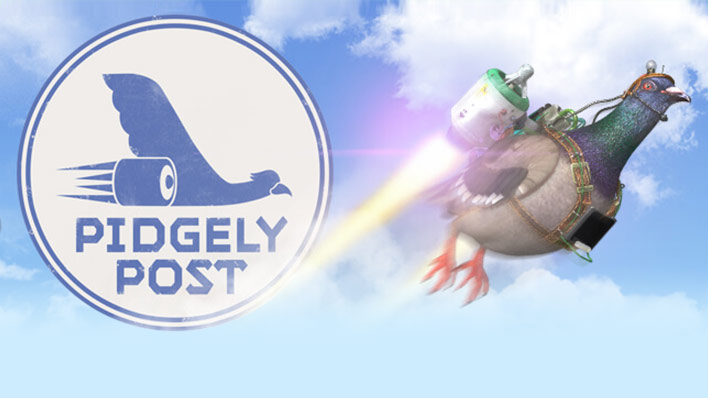
Press the TVOKids button to access NASA’s Jet Propulsion Laboratory’s site.
TVO kids (Opens in a new tab)